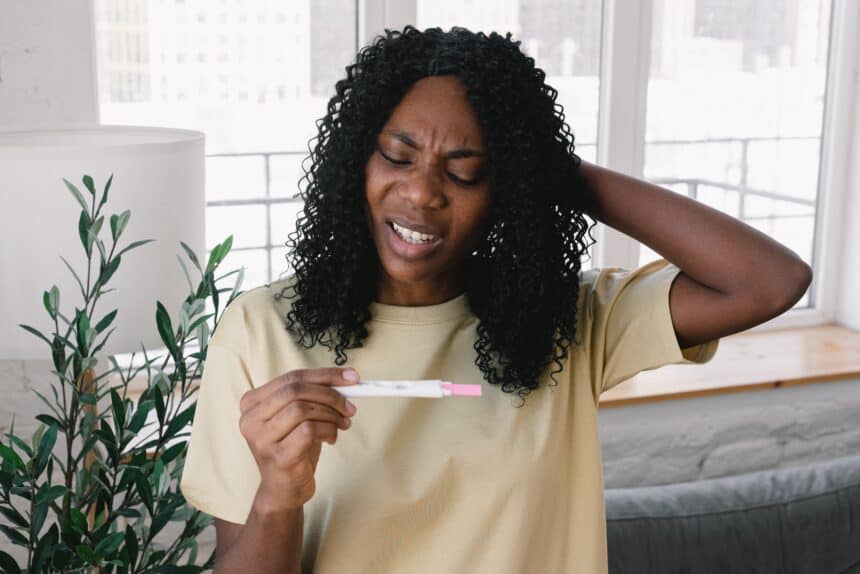It’s happening to many ladies, especially those who test often and immediately after missing their period. You take a home pregnancy test, follow instructions to the tee without any user error, and then a faint line on a pregnancy test kit shows up.
What does it mean? Am I pregnant? Or is the pregnancy test giving me false results? Is it a positive result? According to the general instructions on any test, any noticeable line on a home pregnancy test indicates a positive result. No matter how faint or bold.
If you are annoyed by the faint positive line on your pregnancy test, you are not alone. All parents trying for a baby are eager to check and repeatedly recheck to see when and if their efforts have paid off.
Chances are, you have stocked on home pregnancy tests, and now you are using them regularly whenever you feel the slightest sign or a symptom of pregnancy. And you don’t always like the results you are getting. But even though home pregnancy tests are a great and affordable way of checking, you may get many false positives no matter how sensitive it is when using the stick too soon. This is because you don’t have enough of the hCG produced by your uterus yet.
Statistics show that blood tests best detect early pregnancies at this point.
Home Pregnancy Test – hCG Detection
The unfertilized egg after conception becomes fertilized, and you have officially conceived. However, even though you have conceived, the hCG is not high enough to be detected in your urine.
Indeed there are the high-sensitivity home pregnancy tests on the market that claim to be able to detect pregnancy up to 6 days before the missed period, but that could still be unsuccessful if your body is not producing enough hCG initially. All women are different, and that does not mean anything bad. It simply means that your system will catch up once enough days have passed.
To help you understand why your pregnancy test may give you a faint line or a false negative, here are the levels of hCG in your system throughout the different stages of pregnancy.
- After conceiving, up to four weeks after the last period, the hCG levels grow from 0-750 mIU/mL.
- With the coming of the fifth week, the pregnancy hormone ranges between 200-7000 mIU/mL.
- In the sixth week, it peaks at 200–32,000 mIU/mL.
- In the seventh week, the levels of this hormone are known to drop to between 3,000 to 16,000 mIU/mL.
- In weeks from eight to twelve, the hCG levels peak at 32,000–210,000 mIU/mL. This is as high as those rates can go, and you will see how the hCG drops or maintains levels in the following weeks.
- In the thirteenth to the sixteenth week, the hCG holds steady between 9,000 and 210,000 mIU/mL. After this period, the hCG significantly drops.
- From the seventeenth to the twenty-ninth week, the pregnancy hormone drops to 1,400–53,000 mIU/mL.
- And in the final stages of the pregnancy, from week thirtieth to forty-first week, the levels are known to stay consistent around 940–60,000 mIU/mL.
Based on this data, you now know that as time passes after conceiving, your hCG levels grow and are all the more easily detectable with a pregnancy test; hence the results will be more accurate. When your levels are between 12.5mIU/mL and 30mIU/mL, testing too early may give you a faint line on a pregnancy test or even a false negative as most home pregnancy tests are sensitive to human chorionic gonadotropin levels of 25 mIU/mL to 40 mIU/mL.
With that said, let’s return to the faint line on a pregnancy test, why you may get it and how to interpret it based on when you are testing.
Reading the Home Pregnancy Tests Results
A pregnancy test is a very convenient tool for finding out if you are pregnant or not from the comfort of your home. They guarantee privacy, and you don’t have to pay for the blood test at your doctor’s office. However, the home kits can be pretty confusing when very early in your pregnancy.
Here’s how to read those little faint lines or plus sign that appears on the results window.
What Does a Faint Line on a Pregnancy Test Result Look Like?
There are a few different tests on the market. The digital ones are relatively new, and they display “Pregnant” or “Not Pregnant” clearly with letters. You cannot go wrong with those as there are no faint or bold lines to get confused by.
These test results remove the possibility for an evaporation line too. Additionally, there are those types of tests that show a plus or a minus. The plus indicates “Pregnant,” while a minus shows “Not Pregnant.” You may notice an evaporation line or even a faint positive line if early pregnancy is detected on such a test.
Then there is the home test with lines. This one shows one line for not pregnant and two lines for pregnant. The first control line should appear immediately after processing your urine to indicate that the test is valid. Then after 1-7 minutes (depending on the instructions of the test), a second pregnancy test line will or will not appear based on whether your uterus is producing enough hCG or not.
The second faint positive line is the one that detects your pregnancy, but if the first one does not appear at all, then it means that the test is not working. At that point, you should dispose of it and retest it with another one. In this home test, there may be evaporation lines too.
The second line is the one that may be faint or bold and the one that confuses many women who are trying to conceive and test often.
Firstly, you have to make sure that you are following the instructions on the test. This is of utmost importance if you have to get the correct result. Some tests come with a dropper where you take urine and drop it in the window. But also, some need to be placed under the urine stream for about 5 seconds to analyze the urine.
Then, when you are sure that you have done everything right and still get a barely visible second line, it means that you are pregnant but testing very early in your pregnancy. So, the test detected some hCG levels in your urine but not enough to color the second line.
When you retest once you are further along in your pregnancy, the test will confirm that you are expecting, and the second line will be bold enough to reflect that.
What Does it Mean For You?
A very faint line on pregnancy tests is still a light positive line. The faint lines only mean that there is not enough human chorionic gonadotropin (hCG) in your body to be detected. This pregnancy hormone is produced by cells that will become the placenta after implantation.
The faint lines on the test will tell you that implantation has occurred and you’re in the early stages of pregnancy. Do the test again in seven days to be sure that you are pregnant. Once the second line is dark enough, you know you can safely start getting excited.
However, the positive pregnancy test result may have been due to the evaporation line. You may see this evaporation line as a positive line even though the result is negative.
Another possible scenario when getting a weak second line is that you were only briefly pregnant. This could happen when you get a weak line on your test, and then a couple of weeks later, you get your period back. This means that you had a very early miscarriage that you didn’t even feel, but the test detected a slight rise in the pregnancy hormone.
This is also possible if you have experienced a chemical pregnancy. Such occurrence is rare, but it does happen, and some women are entirely asymptomatic to it. A chemical pregnancy happens up until five weeks of pregnancy and cannot be detected by an ultrasound scan. An ectopic pregnancy is also possible, and it occurs in the fallopian tube. It isn’t viable but will give a positive result on the pregnancy test in the early pregnancy stages.
Barely Visible Home Pregnancy Test Result: Could it Be Negative?
Even barely visible pregnancy tests are still positive because some content of hCG in your urine was detected. However, it might indicate a false positive for actual pregnancy or an early pregnancy loss. Although most tests guarantee 99% accuracy when testing on the first day of the missed period, a false-positive result and a false negative pregnancy test result are still possible.
Here are some instances in which you may get an incorrect result with a home pregnancy test.
Women in menopause or perimenopause state will miss their period. If they don’t know they entered the perimenopause state and take a test, they may get a false positive. This happens because of the abnormally elevated levels of luteinizing hormone.
Suppose a woman takes fertility drugs with hCG and other medications prescribed by her health care provider to aid in conceiving. In that case, it is possible that she tests positive (even with a barely visible line) although she isn’t pregnant. This could be the case with hCG injections as part of fertility care. At that time, you should wait at least seven days for the hCG levels to normalize before taking a test.
On the other hand, a test may give a false negative when you are not testing first thing in the morning. The morning urine is the most concentrated with the pregnancy hormone levels, so if you test later in the day and don’t have enough hCG to start with, you may get a false negative.
If you drink too much water first thing in the morning, you may dilute your urine even though you are testing with the morning urine. So, it is crucial to test before you have eaten or drank anything.
Another possibility when a test might be wrong is if it’s expired or has been exposed to the sun for a long time before you used it. This is why buying pregnancy tests from the pharmacy is the best way of ensuring a correct result. Also, pay attention to the control line. It should appear immediately after you put urine on the test stick. If not, then the test is invalid from the start, and you should retest with another one.
Faint Positive Pregnancy Test Bottom Line
So, if you had gotten a barely visible positive test, does that mean you are pregnant? Yes, that almost always means you are pregnant. Still, when you get such a result, redo it after a week. If you are still getting a barely visible line, do a blood test to confirm your state. The sooner you confirm you are expecting, the better it is for your baby and yourself.

